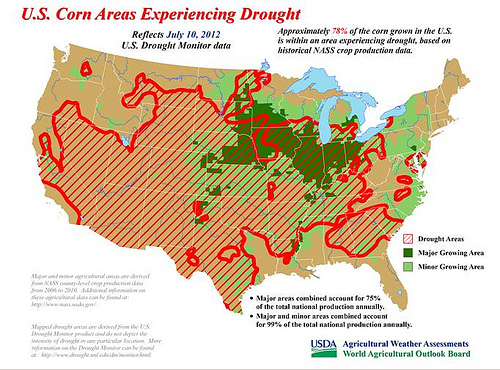
Climate Change, Drought, and National Security
 By the end of June, 55 percent of the American homeland was in moderate to extreme drought conditions according to the National Oceanic and Atmospheric Association. To make matters worse, much of the dry weather is concentrated in our nation’s farming regions leaving 60 percent of the American corn crop struggling to grow.
By the end of June, 55 percent of the American homeland was in moderate to extreme drought conditions according to the National Oceanic and Atmospheric Association. To make matters worse, much of the dry weather is concentrated in our nation’s farming regions leaving 60 percent of the American corn crop struggling to grow.
Droughts present cultivators with an impossible farming environment of dry soil and relentless sunshine. Even in places with adequate irrigation systems, expenses associated with watering thirsty crops multiply during droughts. “It’s just an astronomical extra amount of money we’re having to spend,” Bruce Goodrich says of the expenses he’s incurring irrigating his Missouri rice, corn, and soybean crops.
As farming inputs become costlier and more intensive, so too will the price of food in the grocery store. Wells Fargo & Co. agricultural economist, Michael Swanson, claims the adverse weather could cost the U.S. economy as much as $50 billion. Fortunately, the American consumer and economy will be able to weather a drop in food supplies and subsequent price spikes. This may not be the case for much of the world.
In most developing nations, a large percentage of populations live in rural areas and are dependent upon farming for their livelihood and income. Moreover, millions of those farmers engage in subsistence agriculture. Growing only enough food to feed their families, they derive no income from their crops. Droughts have obviously dire implications for these families’ food and financial security. That being said, droughts in other parts of the world may boost these poor farmers’ income to the extent that the drought raises global food prices.
Farmers all over the world, industrial and subsistence, should be braced for even more dry spells as climate change takes hold. Climate scientists have long warned of climate change manifesting itself through increased incidence of extreme weather events like prolonged drought or abnormally heavy rains. With crippling drought currently occurring in the United States, Kazakhstan, Serbia, and Brazil, it seems as though those warnings have come to fruition.
Droughts threaten U.S. national security directly and indirectly. The USDA recently estimated that 38 percent of the U.S. corn crop is in poor or very poor condition. Weak crops translate into higher food prices which puts pressure on consumers’ wallets. With a larger portion of consumers’ spending dedicated to food, expenditure on other goods and services weaken causing a slowdown across economic sectors. As former New Jersey Governor Christine Whitman said, “There will be costs to our economic security from climate change- and significant ones at that.”
U.S. security may be compromised indirectly from destabilization in other drought-stricken nations. Food shortages increase competition for vital food resources especially in developing countries that are deeply entrenched in agriculture. These nations, located primarily in sub-Saharan Africa and the Middle East are often vulnerable to violent conflict. Food shortages and higher prices contributed to widespread civil unrest in much of the Middle East last year according to many analysts. Conflicts like the Arab Spring threaten U.S. interests and may require the involvement of U.S. combat troops, as seen in the case of the Libyan Civil War.
If climate change continues to intensify droughts around the world, food scarcity will become increasingly prevalent. And, as scarcity leads to destabilization in conflict-prone areas, the U.S. will have to put more and more American lives at risk.
While the economic impacts of drought are clear and present at home, the threats posed by drought in Africa and elsewhere, though less obvious, are certain and tangible. Because of these threats, action to combat climate change and its impacts is essential to national security. With most of the world hesitant to enact climate legislation, the United States should lead by example and begin combating the unconventional security threats a changing climate poses.






